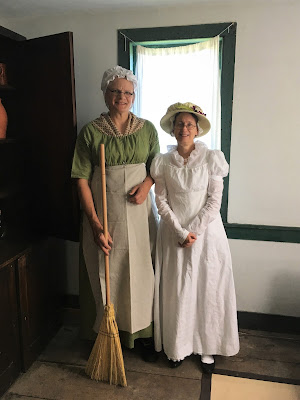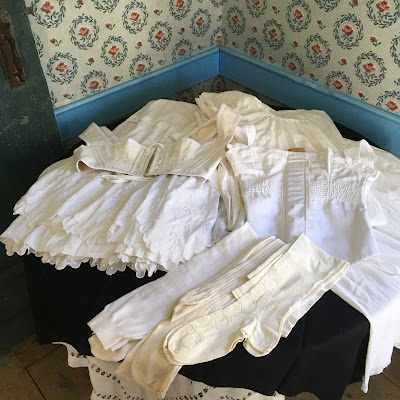"My mother is preparing mourning for Mrs. E. K.; she has picked her old silk pelisse to pieces, and means to have it dyed black for a gown - a very interesting scheme" - Jane Austen to Cassandra, October 7, 1808
 | |
| Commemorating the 200th anniversary of Jane Austen's death. December 16, 1775 - July 28, 1817 |
200 years ago, on this day, July 28th, one of the greatest English novelists, Jane Austen, left this world for another. Her legacy, however, lives on through masterpieces like Sense & Sensibility (1811), Pride & Prejudice (1813), Mansfield Park (1814), Emma (1815), Northanger Abbey (1817), and Persuasion (1817), among other works.
So I thought it fitting to write about this past weekend - the annual War of 1812 and Jane Austen Weekend - my favorite event at the Genesee Country Village & Museum! In fact, it appears that I've dedicated an entire post to it for the past couple of years: 1812 Weekend in Genesee Country (2016) and 1812 Weekend at the Genesee Country Village (2015).
Friday, June 23rd - Setting Up Shop
 |
| The dressmaker at work. |
To commemorate the 200th anniversary of Jane Austen's death, the dressmaker and I put together a special mourning display. On the Wednesday before the event, Rhonda contacted me with the brilliant idea, and that Friday, two days later, we were setting up her shop. Together we collected every scrap of ribbon, lace and trim, fine silks and wools, accessories and the latest fashion plates a lady might need to remain fashionable at every stage of mourning. Two hours and a laundry basket, several various bags and bonnet boxes later, the shop was arranged for the weekend.
On the main work table, draped in black sateen, the dressmaker offers the finest black, silk ribbon, reticule and leather gloves for full morning, as well as a checked, silk bonnet, ombre ribbon, length of white china silk, and dainty cotton gloves for half morning. Propped up on an early copy of Sense & Sensibility and Northanger Abbey, the silhouette of Jane Austen is framed for all to see.
In the later years of the Regency Period, the British observed quite a bit of royal mourning. In the Fall of 1817, Princess Charlotte died after giving birth to a stillborn child. A year later, in 1818, the Queen Consort Charlotte died, as well as King George III in January of 1820, ending the Regency Era. Six days later, the Duke of Kent passed, leading the country into double mourning. Periodicals like Ackermann’s Repository and La Belle Assemblee would have printed the latest fashions for mourning:
 |
| Mourning fashion plates from Ackermann's Respository. |
Right above the table is fully stocked shelf with all sorts of antique lace lengths, ribbons and trims, millinery flowers, gloves and other small accessories. As well as several lengths of silks of various weights in black, white, greys, and even a purple and grey plaid taffeta for half mourning.
Mourning customs were observed to various degrees by class, and dictated not only what was socially appropriate behavior, but gave a dress code that divided the mourning period into two distinct stages - full and half mourning. In the first period of mourning, black, the traditional color that dates back to the Romans, was the preferred color, with crape or bombazine, a silk with a matte finish, being the indicator fabrics. In the half mourning period that followed, more colors were introduced with greys, purples and even white.
 |
| Fabrics, trims and millinery ribbons for all stages of mourning. |
While the wealthy could afford to make separate wardrobes for mourning, most people transformed existing garments for mourning, covering bonnets in crape and dyeing old dresses. Even the poor made attempts to follow mourning customs with a black ribbon or armband.
 |
| My favorite part was arranging the shelf! We really liked the idea of cascading ribbons and trims from the band boxes. |
To complete the left side of the shop, a gown (which you may recognize as the one that Samantha made!) suitable for half mourning hangs with a double ruffle chemisette.
 |
| Half mourning dress with a double ruffle chemisette, central work table and millinery shelf. |
On the other side of the shop, we draped the mirror with black point d'esprit, and the chest with a length of black silk. Several grey wool dress lengths and a white cotton lawn sit, waiting to be made into mourning dresses.
On the other work table, also draped in black, we arranged an undergarment display for the visitors. The items included a shift, long pantalettes, three pairs of stockings, short stays, long stays, and an antique petticoat.
 |
| My new short stays and an antique petticoat from my collection. It features two scalloped flounces with gorgeous white work - a very, very lucky find! |
 |
| Three pairs of stockings - plain cotton, ribbed silk, and an antique set of clocked stockings. |
Lastly, in the middle of the shop, where the dressmaker usually works, hence the small stand with personal belongings, we filled the scrap basket with grey and purple calicos, as if several dresses had already been sold.
With the shop ready to go for the weekend, the dressmaker and I locked up and had a lovely dinner with her neighbor, Kate from the apothecary shop. Having only exchanged brief hellos in the past, it was a great pleasure to get to know Kate. She is a fantastic lady with a true passion for historical education and appreciation for a multi-cultural past. It really made day, if not the week, to sit in the presence of such wonderful company as Rhonda and Kate! I sure hope that she will return again next year.
 |
| Kate, the apothecary, and Rhonda, the dressmaker. |
Saturday, June 24th - Event Day One
The dressmaker and I arrived bright and early in the morning to start our days. (My family and I had the privilege of hosting and the pleasure of her company for the weekend as her carriage ride would be quite a distance more than mine. We all like Rhonda so much, and it is such an honor to call her friend!)
 |
| The dressmaker in her shop. Photograph by Judy J. |
One of the much anticipated festivities of the weekend is the Regency fashion show! Unfortunately, I've never been able to attend the show as I am only an indentured servant at Hosmer's Inn, but, very fortunately, there are always plenty of likeliness's circling about so one does not have to miss out on the fancies. This year, there were lots of models:
 |
| Regency fashion show. Photograph by Ruby Foote, official museum photographer. (Via: Facebook) |
For a fourth time now, I worked at Hosmer's Inn serving the reenactor luncheon. The twin, a.k.a. Ariana, and I, jokingly referred to as the indentured servants of Hosmer, plated lunch in the woodshed/food prep area. Day one's lunch included macaroni and cheese, dressed peas with greens, salted ham, apple sauce, salmagundi with the special Hosmer dressing, pickled beets and spicy East India pickles, and a "plain bun" with either cherries or caraway seeds. For dessert there was bread pudding with a brandy maple sauce - yum yum!
 |
| Lunch, day one. |
The day ended with a little shopping, and the annual tradition of talking the twin, Ariana, into buying lots and lots of pretty fabrics! What can I say? Regency Revisited AND Fashions Revisited were there!
There was also a small, low key soirée that night at the Inn. Met four new folks from Maryland that were very kind and very knowledgeable, and I hope that they all plan on returning next year. Lively conversations late into the evening with a general air of friendliness. I'll try to take pictures next time...
Sunday, June 25th - Event Day Two
Back to Hosmer's Inn for a second day of plating lunches! Today's menu included a potato and carrot mash, stewed beef with gravy, asparagus, applesauce, salmagundi with the Hosmer house dressing, pickled beets and spicy East India pickles, and "plain buns" or whole wheat rolls. For dessert, there was left over bread pudding with the brandy maple sauce or gingerbread and seed cakes. All of it using 19th century receipts or recipes, prepared onsite with our own ham and beef, and very, very tasty!
 |
| Lunch, day two. |
We couldn't have done it without Pamela, historic cook and volunteer, and the "Canadian ladies" Bonnie and Norma who prepare most of the meal in the historic kitchen at Hosmer's Inn!
 |
| Bonnie and Norma preparing yet another refill of the popular salmagundi dish. |
As a whole, I was very pleased to see some familiar faces over the weekend, including Lisa and the Meryton Assembly Dancers, as well as another Lisa and her little "B."
 |
| The most ADORABLE picture ever! Lisa & little B. |
And had the pleasure of making new acquaintances, including meeting Lydia Fast of Regency bonnet fame! (Aaahhh I met Lydia Fast!!)
Finally, it wouldn't be 1812 weekend without a few shenanigans with the twin...this year we kept it pretty tame with picking roses at Shaker, but just wait until next time ;)
 |
| Oh Ariana, you're so cute! |
After packing up the dress shop, Rhonda and I had one last dinner together. Then, saying our good byes, parted ways. And, with that, 1812 weekend was over...'till next year!
 |
| The dressmaker and I. |
Regency Mourning Resources
- Regency Mourning - Published on the blog, Jane Austen's World, this article details several customs surrounding mourning and the appropriate dress throughout the Regency period. It also provides several web links for further study.
- Dressing for Mourning in the Regency - This article from the Jane Austen Centre provides in-depth descriptions and period sources for understanding full and half-mourning wear.
- Mourning Becomes Her: Regency Mourning Dress & Customs - From the Risky Regencies blog, this post discusses mourning fashion within the "Death Becomes Her" exhibit that was displayed at the Metropolitan Museum of Art in New York City, and gives a great overview and history of mourning customs during the Regency Period.




































